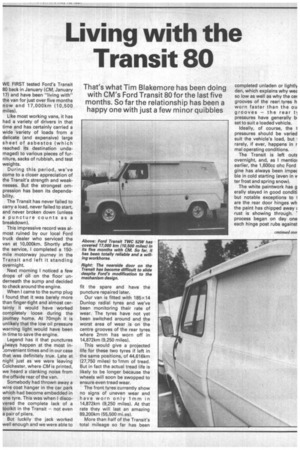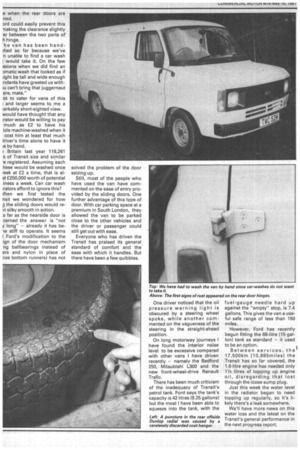Living with the Transit 80
Page 55

Page 56

If you've noticed an error in this article please click here to report it so we can fix it.
That's what Tim Blakemore has been doing with CM's Ford Transit 80 for the last five months. So far the relationship has been a happy one with just a few minor quibbles
WE FIRST tested Ford's Transit 80 back in January (CM, January 17) and have been "living with" the van for just over five months now and 17,000km (10,500 miles).
Like most working vans, it has had a variety of drivers in that time and has certainly carried a wide variety of loads from a delicate (and expensive) large sheet of asbestos (which reached its destination undamaged) to various pieces of furniture, sacks of rubbish, and test weights.
During this period, we've come to a closer appreciation of the Transit's strength and weaknesses. But the strongest ompression has been its dependability.
The Transit has never failed to carry a load, never failed to start, and never broken down (unless a puncture counts as a breakdown).
This impressive record was al most ruined by our local Ford truck dealer who serviced the van at 10,000km. Shortly after the service, I completed a 150mile motorway journey in the Transit and left it standing overnight.
Next morning I noticed a few drops of oil on the floor underneath the sump and decided to check around the engine.
When I came to the sump plug I found that it was barely more than finger-tight and almost certainly it would have worked completely loose during the journey home. At 70mph it is unlikely that the low oil pressure warning light would have been in time to save the engine.
Legend has it that punctures happen at the most inonvenient times and in our case that was definitely true. Late at night just as we were leaving Colchester, where CM is printed, we heard a clanking noise from the offside rear of the van.
Somebody had thrown away a wire coat hanger in the car park which had become embedded in one tyre. This was when I discovered the complete lack of a toolkit in the Transit — not even a pair of pliers.
But luckily the jack worked well enough and we were able to fit the spare and have the puncture repaired later.
Our van is fitted with 185x14 Dunlop radial tyres and we've been monitoring their rate of wear. The tyres have not yet been switched around and the worst area of wear is on the centre grooves of the rear tyres where 2mm has worn off in 14,872km (9,250 miles).
This would give a projected life for these two tyres if left in the same positions, of 44,616km (27,750 miles) to 1mm of tread. But in fact the actual tread life is likely to be longer because the wheels will soon be swopped to ensure even tread wear.
The front tyres currently show no signs of uneven wear and have worn only 1mm in 14,872km (9,250 miles). At that rate they will last an amazing 89,200km (55,500 mi.es).
More than half of the Transit's total mileage so far has been
completed unladen or lightly den, which explains why we so low as well as why the cer grooves of the rearl tyres h worn faster than the ou grooves — the rear t) pressures have generally b, set to suit a loaded vehicle.
Ideally, of course, the 1 pressures should be varied suit the vehicle's load, but I rarely, if ever, happens in r mal operating conditions.
The Transit is left outs overnight, and, as I mentioi earlier, the 1,600cc ohc Ford gine has always been impec ble in cold starting (even in v ter frost and spring snow).
The white paintwork has g erally stayed in good conditi but notable exceptions to 1 are the rear door hinges wh the paint has chipped away rust is showing through. process began on day one each hinge post rubs against e when the rear doors are ned.
ard could easily prevent this -naking the clearance slightly er between the two parts of h hinge.
'he van has been hand;Vied so far because we've n unable to find a car wash would take it. On the few asions when we did find an amatic wash that looked as if light be tall and wide enough mdants have greeted us with: iu can't bring that juggernaut ere, mate."
at to cater for vans of this ! and larger seems to me a larkably short-sighted view. would have thought that any :rator would be willing to pay much as £2 to have his icle machine-washed when it cost him at least that much Iriver's time alone to have it le by hand.
Britain last year 118,261 s of Transit size and similar • e registered. Assuming each hese would be washed once reek at £2 a time, that is alst £250,000 worth of potential mess a week. Can car wash rators afford to ignore this? /hen we first tested the nsit we wondered for how 3 the sliding doors would reln silky smooth in action.
s far as the nearside door is cerned the answer is "not y long" — already it has be-le stiff to operate. It seems Ford's modification to the igo of the door mechanism ng ballbearings instead of ers and nylon in place of nze bottom runners) has not
solved the problem of the door seizing up.
Still, most of the people who have used the van have commented on the ease of entry provided by the sliding doors. One further advantage of this type of door. With car parking space at a premium in South London, they allowed the van to be parked close to the other vehicles and the driver or passenger could still get out with ease.
Everyone who has driven the Transit has praised its general, standard of comfort and the ease with which it handles. But there have been a few quibbles. • One driver noticed that the oil pressure warning light is obscured by a steering wheel spoke, while another commented on the vagueness of the steering in the straight-ahead position.
On long motorway journeys have found the interior noise level to be excessive compared with other vans I have driven recently — namely the Bedford 250, Mitsubishi L300 and the new front-wheel-drive Renault Trafic.
There has been much criticism of the inadequacy of Transit's petrol tank. Ford says the tank's capacity is 42 litres (9.25 gallons) but the most f have been able to squeeze into the tank, with the fuel-gauge' needle hard up against the "empty" stop, is 7.4 gallons. This gives the van a useful safe range of less than 150 miles.
However, Ford has recently begun fitting the 68-litre (15 gallon) tank as standard — it used to be an option.
Between services, the 17,500km (10,885miles) the Transit has so far covered, the 1.6-litre engine has needed only 11/2 litres of topping up engine oil, disregarding that lost through the loose sump plug.
Just this week the water level in the radiator began to need topping up regularly, so it's likely there's a leak somewhere.
We'll have more news on this water loss and the latest on the Transit's general performance in the next progress report.




































































































































